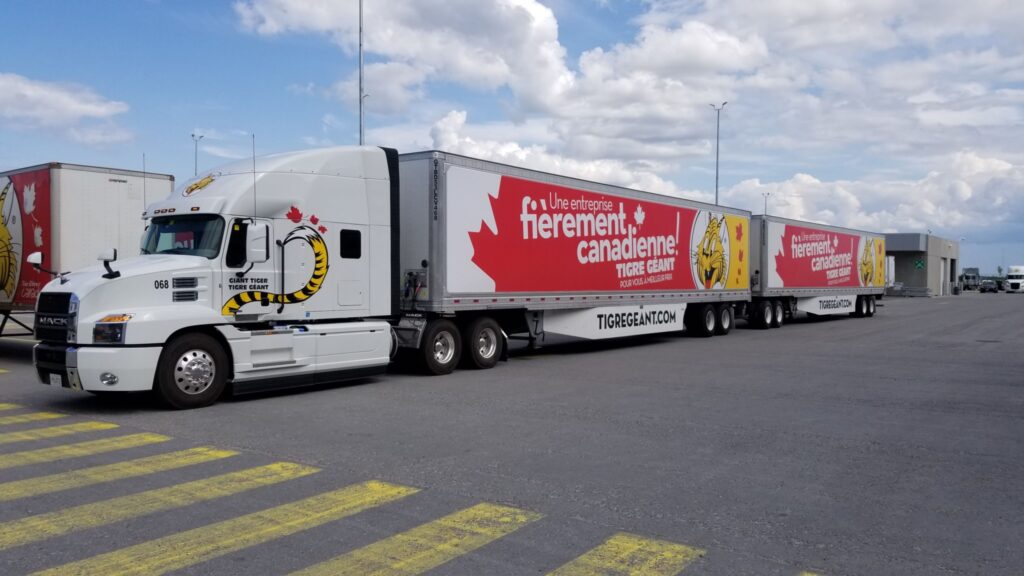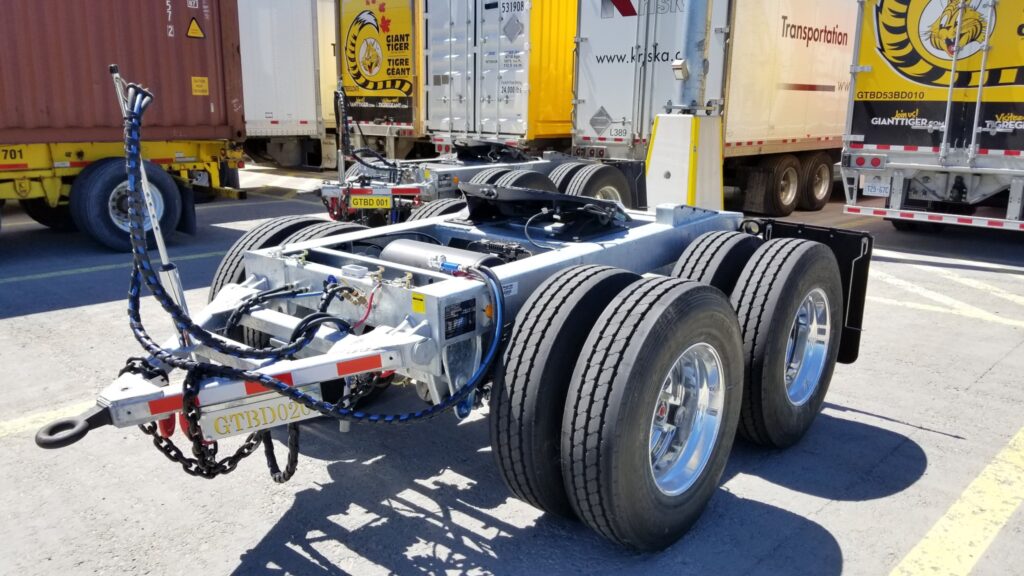Playing the long game: Are LCVs right for your fleet?
Several of Giant Tiger’s tractor-trailers are pulling a decidedly longer tail as they travel the Ontario-Quebec corridor between Windsor and Riviere-du-Loup. Each day more than 10 of them take the form of long combination vehicles (LCVs) and their paired 53-foot trailers.

“LCVs are a significant part of our operation,” says James Johnstone, the discount retailer’s associate vice-president – transportation.
The right to haul such configurations is still heavily restricted, of course. Additional requirements apply to everything from the horsepower under the hood, to braking and stability systems, driver training, and allowable routes. But they deliver more than additional freight volumes per driver. There are potential safety and environmental gains as well.
When Alberta Infrastructure and Transportation studied collisions that occurred between 1999 and 2005, it found that LCVs were involved in fewer fatalities, injuries and property-damage collisions per million kilometers once traffic exposure was considered. More than half of the collisions that did occur were limited to single vehicles, usually at night or when crossing paths with wildlife.
The Ontario Ministry of Transportation, meanwhile, counted more than 45,000 one-way LCV trips per year, and calculated that the equipment eliminated 9 million tonnes of greenhouse gas emissions in the process. And there is a direct link between unwanted GHG emissions and fuel economy.
“Each LCV uses about 1/3 less fuel than two tractor-trailers that would carry the same amount of freight,” the ministry concludes. In one analysis, the LCVs generated emissions 30-37% lower than those from a five-axle tractor-semitrailer.
Despite the advantages, there are limits.
“Obviously with the time and location restrictions on LCV traffic in Ontario, LCVs are not for everyone,” says Adam Wolk, maintenance director at Challenger Motor Freight. The units traveling in that province are restricted to 400 Series highways, and require terminals to be located within 2 km of an assessed and approved highway interchange.
But the fleet headquartered in Cambridge, Ont. now has 1,000 LCV-capable trailers, and hundreds more that could be easily converted depending on market conditions, he adds.

The equipment
The need for extra pulling power is one of the most obvious equipment needs associated with an LCV. A memorandum of understanding between Ontario, Quebec, Nova Scotia and New Brunswick sets it at a minimum of 460 hp and 1,650 lb-ft. A second memorandum governing B.C., Alberta, Saskatchewan and Manitoba requires one horsepower for every 160 kg.
“We spec’ all units to meet or exceed the LCV tractor requirements established by the MTO [Ontario Ministry of Transportation],” Johnstone says, referring to the Giant Tiger fleet. “We typically aim a little higher than the minimum horsepower requirements.” The fleet runs equipment with 505 hp and 1,750 lb-ft of torque.
“Our outbound loads to stores are not heavy, but we can get heavier loads inbound to our DC. We find the higher power torque is less strain on the truck and quicker to get to cruising speed. It ends up saving more fuel than a truck that is meeting the minimum requirements, and perhaps struggling to get moving.”
That doesn’t always mean a bigger engine displacement, though.
“Old-school thinking used to dictate going with higher displacement – 15 liter versus 13 liter,” Wolk says. “It has been our experience that the recent generations of 13-liter powerplants are just as capable on LCVs, with the exception that any engine is going to accelerate more slowly with two loaded 53-foot trailers compared to one.”
Under the eastern MOU, top speeds are set at 90 km/h. Out west, the speeds can creep up to 100 km/h, but in snow and icy conditions the equipment is only allowed to pass vehicles that are traveling no faster than 70 km/h.
Other requirements apply to the ‘woah’ rather than the ‘go’. Tractors require electronic stability control. The compressors used in the eastern trucks need to deliver 465 liters of air per minute. Air systems in the west need to generate 50-90 psi at 1,250 rpm in two minutes or less with the tractor, and four minutes or less with the trailer.
Johnstone, meanwhile, notes that all the Giant Tiger LCVs are outfitted with disc brakes.
Some of the maintenance needs can be unique, specifically where the trailers are connected.
“Pintles seize and require a fair amount of upkeep to keep consistently operational if they are not used regularly,” Wolk explains. That can be a challenge when LCV-capable trailers are used in non-LCV applications. “We have tried a number of different approaches to minimize the work required, but at the end of the day, pintles require additional maintenance expense.”
There are lessons to learn, too. “Converter dollies have a tendency to ‘wander’ more than any 53-foot trailer, and can be difficult to track down,” he adds. “For maintenance, tractor or trailer, the added complexity of LCV equipment adds more maintenance expense, and you have to be prepared for that – operationally and budgetarily.”
Giant Tiger, meanwhile, has chosen to fully galvanize its LCV dollies. This adds to a process of selecting fully galvanized or stainless components on typical trailer rear door frames and headers, and galvanized cross members.
“While we’re not going to run a dolly longer than says six to eight years, we always want it to look its best. The cost addition is insignificant,” Johnstone says. “From a maintenance perspective, it’s much easier to work on equipment that is not covered in surface rust, bubbled paint, etc.”
Air lines are mounted on the same side of the pintle hook, too.
As predictable as the maintenance regimes can be, there are still operational challenges to consider.
“No matter how much planning you build into your schedule, always expect the unexpected with LCVs,” adds Giant Tiger’s Johnstone.
“Weather, accidents, road closures, driver sick calls. You don’t need to only cover one load. You have two.”
The need to switch form 10 LCVs to 20 traditional tractor-trailers can switch with a moment’s notice.
CORRECTION: In Ontario, the lead trailer must not be equipped with a functioning independent roll stability system (RSS) unless it is also capable of automatically applying the downstream (dolly and second trailer) brakes. An original version of this article did not include the reference to downstream requirements.
Have your say
This is a moderated forum. Comments will no longer be published unless they are accompanied by a first and last name and a verifiable email address. (Today's Trucking will not publish or share the email address.) Profane language and content deemed to be libelous, racist, or threatening in nature will not be published under any circumstances.
I see these Giant Tiger trucks on the 401 great looking fleet
My hat is off to those drivers. It is bad enough trying to find a place at times for a regular truck/trailer combination. Must be beyond horrible for those drivers.
Regular trucks in LCV spots, people towing campers park there like they own the spot. Few spots, lots of occupants though.
Once again, my hat is off to them.
Where LCV is a creation of the trucking industry to increase productivity and becoming more effecient,
In 2020, the LCV is the solution of the large distribution Center.
The trucking industry to benefit of LCV need to increase weight to 80 or 90 tons in order to compete and built efficiency, As the rail industry is promoting intermodal container and not supporting piggyback operation, time justify heavier load and increase LCV, GWC
if we have a lcv permit for quebec do we need a specific one to run lcv in ontario
Great article on LCV’s. Hauled them for many years myself. Loved doing it. Cheers.